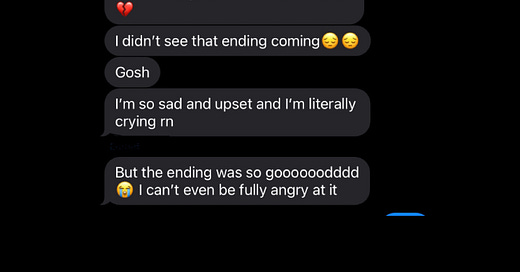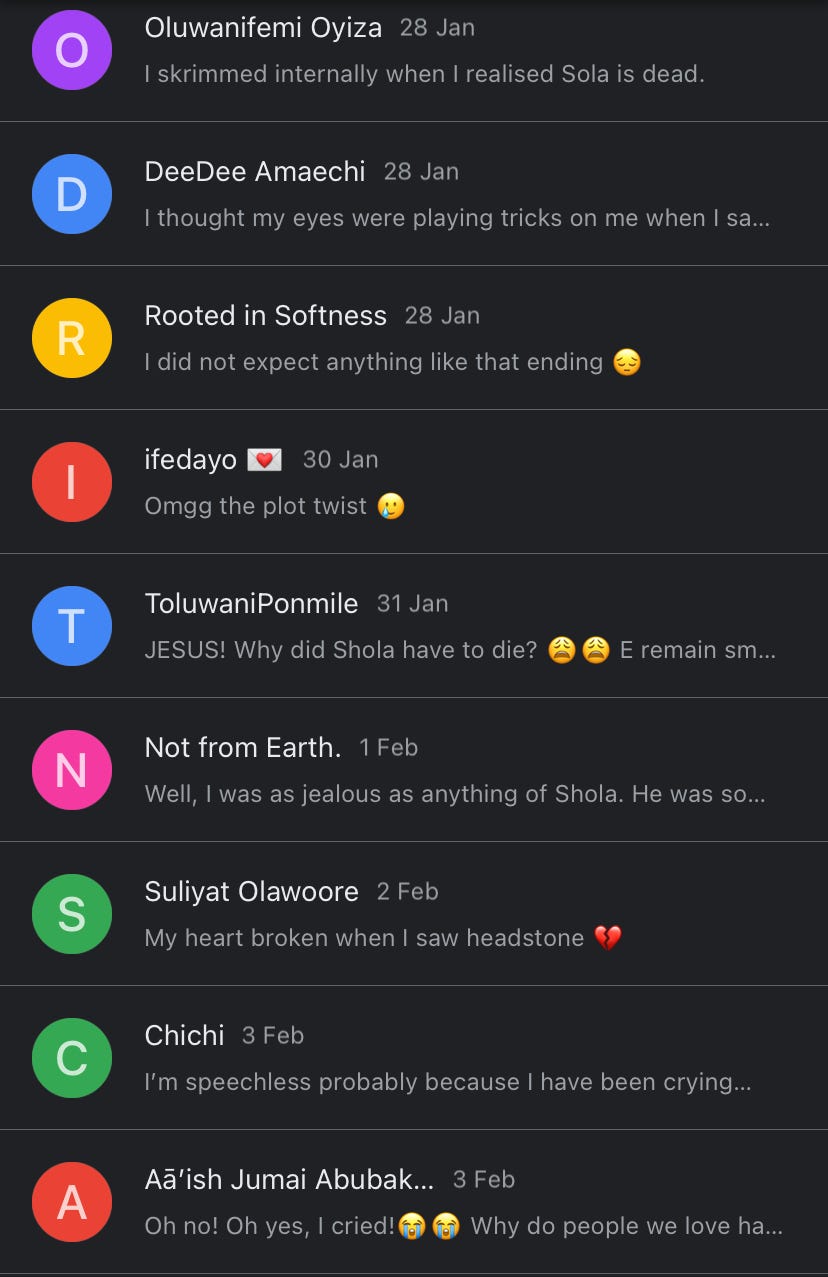For this article, I’m going to break down one of my most popular fiction stories, and my personal favourite, My Shola, My Love.
There will be spoilers, so if you haven’t read it yet or for a better understanding of this post, I suggest you do that first.
Click HERE to read the story.
As readers, we pick up stories so that we can feel something, so as a writer, you want to ensure that you’re always evoking the right emotions in your readers.
Even if it’s not the ones they would like to feel.
An anti-climax is a disappointing end to an exciting or impressive series of events.
You don’t want your stories to end this way.
(Think of a movie or book that you finished and was annoyed because the ending was so flat compared to the hype and drama of the rest of the work.)
There’s a very thin line between disappointing your readers in a manner they’ll “love” and disappointing them in a manner that’ll leave them angry or irritated.
When you do it well, they will end up feeling a bittersweet disappointment.
The kind that will make them sit in silence after finishing your story, replaying the images in their head and re-reading the words while shedding a tear or two.
Maybe they’ll even curse you out for breaking their heart.
Or they’ll be left with their mouths open in awe because they cannot believe what they just read.
However, to do this, and to do it very well, you must earn it.
Your readers must know and agree with you that your reason for disappointing them is justified.
If you under do it, they’ll end up feeling cheated and frustrated.
If you overdo it, they’ll see it coming from a mile away.
So, balance.
I found that balance in this story, and as you can see from the comments below, it worked exactly how I wanted it to:
Let’s break it down so you’ll see exactly how you can recreate it.
Give them a reason to care.
For this story, the reason you cared was because of the characters involved.
From the first line, the emotional stakes are built.
The protagonist, Omolola, is deeply in love with Shola.
The way she describes him with warmth, nostalgia, and longing leaves no room for you to deny the genuineness and the beauty of their connection.
By the time she’s on her way to see him, you want this reunion to happen.
You need it to happen. You expect it to be beautiful and emotional and sweet.
And that’s exactly why the ending hits as hard as it does.
Characters are the heart of every story.
So, if you want your readers to care about the events of your story, give them a reason to care about the characters first.
If they don’t, then nothing else matters.
Make them care.
Make sure they’re standing on solid ground.
Then pull the rug from under their feet and break their hearts.
You’re welcome.
Let the ending be satisfying, even if it’s not what they expect.
As you read the story, I’m sure you hoped that the couple would unite or something, but instead what you got was a dead man in a cemetery.
Yet, it doesn’t feel like a cheap trick.
My Shola, My Love explores grief, love, and loss.
The ending was not written just to “shock” but to deliver a strong emotional resolution.
When you want to end a story or add a twist to it, think less about what your readers want and more about what the story deserves.
When you aim to please your reader, you probably won’t be willing to do your plot the justice it deserves.
Put the story first, then your readers second.
You can make them wish for a different outcome, but leave them only with one that makes sense for the story you want to tell.
Throw them completely off the scent.
In fiction, we call this a red herring.
It’s a “clue” that’s intentionally meant to mislead your reader.
I left quite a few in this story because I didn’t want you to guess or even think in the direction of Shola not being alive.
The biggest example of this was his last text that Omolola kept reading.
On my way. Can’t wait to see you again, Lola mi.
He sent that text months ago before he died, but she keeps reading it in reminiscence like he just sent it recently.
You don’t know that, so you just go with the notion that she will see him soon.
Classic red herring.
Then there’s the tone in which Lola talks about him too. The way she’s nervously excited as she talks about seeing him soon and talking to him again.
Which, in her defence, she was. Just not how you expected.
On the flip side, you don’t want to lead your reader in a direction that ends up making no sense.
I mentioned anti-climactic endings earlier.
Your readers are not stupid; don’t try to play on their intelligence by lying to them.
Lying = Adding things to the story that don’t relate just because you want to “deceive” them.
The fake “clues” you plant, if any, must tie in with the truth of the story.
Your “shocking” twist should not just be shocking but, in retrospect, it should also be obvious.
Make the disappointment feel “earned”.
Your story has to earn the right to get away with hurting your reader’s feelings, making them cry, or getting them angry.
They may not see your twist coming, but when it happens, they should feel like that was the only way it could have ended.
In My Shola, My Love I build-up excitement through Lola.
She’s wearing the dress he bought her. She’s rehearsing what she’ll say. She’s holding onto the last text he sent.
Everything points to a reunion.
But beneath all that, there are small, subtle details that point to the fact that all might not be completely well.
For example: She’s way too nervous for someone going to meet the love of her life, especially since she hasn’t seen him in months.
Also, she keeps telling us how she left suddenly, but she never explains why.
Then there’s the scene outside the cemetery, where the Uber driver’s concerned look lasts for long.
Would he have given her such a concerned look if he dropped her in front of a 5-star restaurant? Exactly.
These details don’t stand out to you on the first read, but when the reveal happens and you realise that Shola has been dead all along, they snap into place.
Then you’re like, “Ohh… damn.”
Everything suddenly makes more sense, and the twist doesn’t feel random or forced because it’s always been a part of the story.
That’s why the ending remains satisfactory, as unexpected as it was.
Let your characters be lovable.
Shola is not just Lola’s “boyfriend”; he’s her best friend, her anchor, her soulmate.
He’s kind, supportive, and deeply in love with her.
He lifts her up. He makes her better.
He represents the true kind of love that we all long to receive.
That’s the reason his death probably left you devastated.
You mourn not just for Lola, but for yourself.
You feel her loss and her hurt like it’s yours.
Like I said earlier, your readers must care about your characters if you want them to care about your story.
You want to make sure they laugh when your characters laugh, cry when they cry, and weep when they weep.
And for this to happen, you need to give them depth and make them feel like real people.
Shola’s absence hurts because his presence mattered.
Readers did not just feel like they lost a character.
It felt like they lost a friend, someone they knew.
Your pacing must be perfect.
Too slow, and the twist is predictable.
Too fast, and it lacks emotional weight.
In this story, anticipation builds gradually.
Lola reflects on their relationship.
She’s anxious. She’s excited. The Uber ride takes time.
By the time she steps into the park, you are holding your breath.
The highly awaited moment is coming.
You can’t wait for these lovers to meet again.
Then… “And that’s when I see it again. His headstone…”
You can’t believe your eyes.
The climax doesn’t feel rushed; it lands perfectly. Simone Biles style.
Make them feel the weight of the loss.
This ties all the points from earlier together.
This is how you make your readers bask in the emotions that you’ve made them feel.
After Shola’s death is revealed, Lola kneels by his grave, and she starts to talk to him.
You’re still reeling from the shock that hit you, but the aftermath of the revelation is also so heavy.
The quiet grief. The way she speaks to him as if he’s still there. The decision to quit her job and stay close to him, even in death.
The raw pain that you can feel in her words when she says:
“This was not the plan we had, Oluwanishola. What am I supposed to do without you, for God's sake!? This is not the love you promised to show me forever o.”
You feel those emotions even deeper.
The ending of your story is not just about what happens but also aboutwhat it means.
Your readers have to feel the true implications of the twist.
Let it linger for a while, and it will stay with them long after they’ve finished reading.
That brings us to the end of this “case study.”
You can probably already tell, but I’m really proud of this story.
I think it’s one of the best I’ve written, and I’m glad many people rock with it.
In summary:
Make your readers care.
Make your readers hope.
And then break their hearts.
When you do it right, they won’t be angry, they’ll be grateful to you.
Because you made them feel something.
The best stories are not always the ones that leave us happy but the ones that leave us reeling with emotions.
One book that did this for me is Looking For Alaska by John Green.
Heart-wrenching story.
(P.S - I only did this “analysis” for the sake of this post. I didn’t think this deeply about all these things when I was writing the story; I just wrote it.
The beauty of storytelling is that most of it comes together unconsciously.
So please, never overthink or overanalyse; just write.)







Thank you so much for this analysis, I do prefer sad endings to happy ones too because of the emotions it sparks🥹.
You are a good writer Ebun, can’t wait to read more of what you have in store for us!
Never overthink, never overanalyze, just write!
You deserve every single one of your subscribers fr!😭❤️